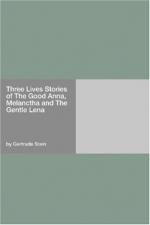|
This section contains 897 words (approx. 3 pages at 400 words per page) |

|
Modernism
When Gertrude Stein composed "Melanctha" in 1905, the twentieth-century upheaval in literature known as modernism was only just beginning. Most of the other major modernist works would come in the years to follow: James Joyce's Portrait of the Artist as a Young Man and Ulysses, Virginia Woolf's To the Lighthouse, T. S. Eliot's "The Waste Land," Jean Toomer's Cane, and D. H. Lawrence's Women in Love. Literary critics, looking back over the beginning of the century, have tended to define modernism according to certain themes, such as alienation, and/or stylistic techniques employed in many of these works. While Stein's style differed from Joyce's and Woolf's, she nevertheless defied many of the same conventions, like making her text much more difficult for a reader used to the clear and supposedly transparent prose of nineteenth-century fiction.
Narrator
Just as "Melanctha" does not follow a course of events clearly from beginning...
|
This section contains 897 words (approx. 3 pages at 400 words per page) |

|




